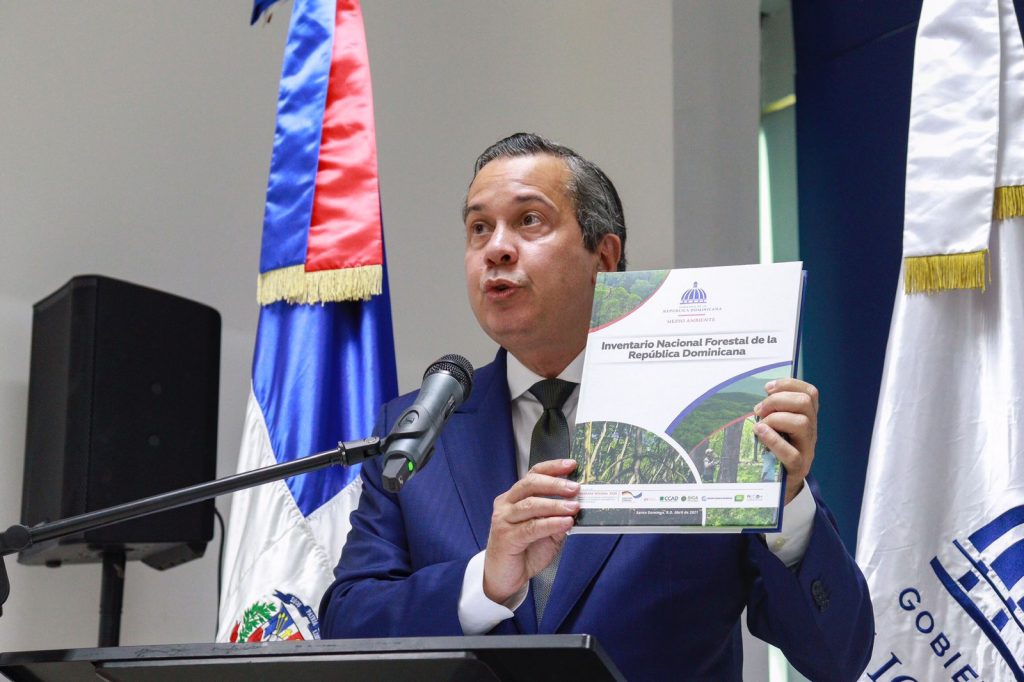
Minister Orlando Jorge Mera presented details of the Forestry Regulation for Forestry Sectoral Law 57-18. While the law dates back to 2018 and passed during the Danilo Medina administration, only now will it be implemented. For its implementation, the ruling was necessary. The ruling has been drafted and was enacted when President Luis Abinader issued Decree 627-21.
Environment Minister Jorge Mera also presented findings of the National Forest Inventory of the Dominican Republic 2021 (INF-RD), which identified 1,814,503 hectares with forest cover in the country. This area is equivalent to 37.7% of the national territory. Jorge Mera said that when the 5.1% of fruit-producing trees is added (coffee and cacao with shade), the total forestry coverage reaches 42.8% of the national territory. This compares to Haiti, where forest coverage is about 2%.
Jorge Mera explained the inventory was carried out at the national level. The Ministry of Environment can now make available updated information on the state of forests, composition and stocks of volume, biomass and carbon. The inventory also contributes to forest preservation efforts and makes more apparent the role of forests in water production.
The publication is to be made available to the general public on the Ministry’s website. Minister Jorge Mera said that it is a living document, in constant evolution. The data was collected by Teledetection system of remote-sensing big data, and has images from the 2020 Planet satellite, as well as incorporates findings of field work.
“It is an extraordinary achievement that deserves all our recognition, especially because Law 57-18, which regulates the country’s forestry sector, had three years, without regulations,” said Jorge Mera.
With this tool, new mechanisms are established to regularize forestry activities to comply with the sectoral law governing the matter, he explained. The German International Cooperation Agency (GIZ) contributed to the drafting of the ruling.
The regulation establishes the formation of the Technical Committee of Forest Management responsible for the approval of forest management plans. The Dominican Chamber of Forestry represents the private sector in the technical committee. Gabriel Peña is the president of the Dominican Chamber of Forestry.
The document contains regulations for forest managers, protection of the forest heritage, the National Forest Ranger Service, forest fire prevention and control, phytosanitary protection, forestry research, and the forestry development fund.
The country’s forest area is composed of seven types of forest ecosystems with an area of 1,814,503 (37.7%) hectares.
The forest types with the highest participation in terms of forest area in the Dominican Republic are: the Humid Broadleaf forest with 39.8%, the Dry Forest with 22.6% and the Semi-Humid Broadleaf Forest with 15.2%.
These three types of forests are the ones that contribute the most to the country’s ecosystems, as they facilitate water conservation, biodiversity protection and carbon conservation.
The inventory determined that the country’s forests currently store a total of 1,833,252,260 tons of carbon (total CO2 stock), with an accuracy of 95%, and that the highest carbon values are found in the soil component with 772 tons per hectare (ton/ha), followed by the tree component with 193 ton/ha (including roots), between them they contribute 98% of the total.
The broadleaf forest has the highest carbon stored with 653,493,100 tons, followed by the dry forest with 453,378,859 tons. The soil of the mangrove forests concentrate the largest amount of carbon.
According to the study, in the case of herbaceous species present in the forests, the average density is 51,399 individuals per unit area, estimated with a sampling error of 22.4%. Considering all forest types as a whole, 95 different species of herbaceous vascular plants were identified in the forests of the Dominican Republic.
Read more in Spanish:
Ministry of Environment
28 October 2021

